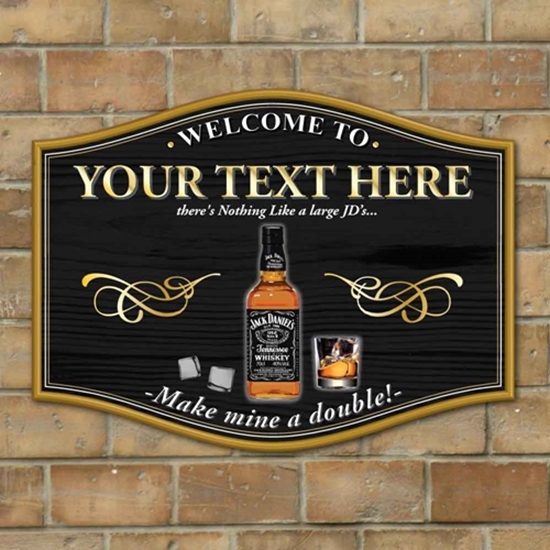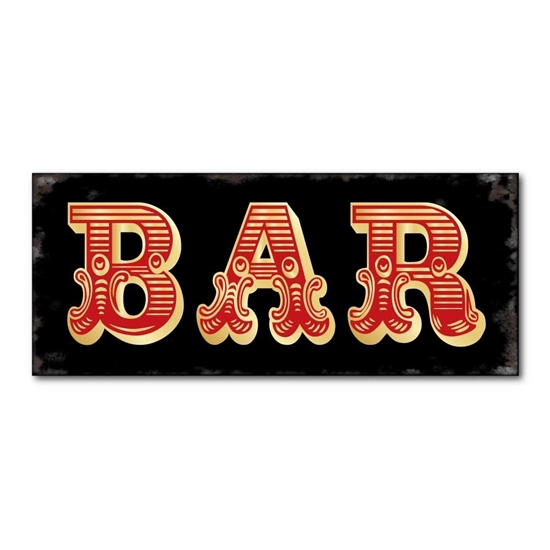Top Advice On Picking Bar Signs
Top Advice On Picking Bar Signs
Blog Article
What Is The Difference Between Bar Signs With Respect To The Location?
The location can make a significant difference in the effectiveness of bar signs. Design, purpose and location. are adapted to specific locations. Here's a breakdown of how bar signs vary based on their location: 1. Signs for the exterior
Purpose: To attract customers from outside and to establish the bar's image.
Big, attractive and often illuminated in the evening.
Materials: These include metals, neon, LEDs, and weather-resistant vinyl.
Examples of these are: Name signs for main bars, logo signs and marquee signs over the entrance.
2. Entrance Signs
The intention behind the welcome card is to give information and welcome customers.
Features: Clear design with branding, and other elements.
Materials: Metal or wood signs.
Examples: "Welcome" signs, operational hours, and special announcements.
3. Interior Wall Signs
The purpose of this site is to provide information, enhance the decor and create a welcoming the right atmosphere.
Features: Available in a variety of sizes and style to match the interior decor.
Materials: Wood, metal, chalkboard, acrylic.
Examples include menu boards, decor signs, and inspirational quotes.
4. Affirmations for Behind the Bar
Use: Highlight the most important aspects like the bar's name, the signature cocktails or specials.
Features: It is well-lit and clearly visible and makes it a great focal space.
Materials: LED, neon, digital displays, chalkboards or digital displays.
Examples: Special boards for drinks, menus and digital displays.
5. Signs for ceilings and hangings
The information on orientation or decoration is from above.
Features Suspended from ceiling, visible from various angles.
Materials They are materials that are light like acrylic foam board and metal.
Examples include hanging decorative signs, or themed props.
6. Tabletop Signs
The purpose is to provide information on the restaurant for customers who are at tables.
Highlights: The font is small and simple to read close.
Materials: Wood laminated with acrylic or paper.
Examples include drink menus table numbers, promotional cards and QR code stand.
7. Restroom Signs
Objective: To clearly mark the location of restrooms.
Highlights: Very visible, with frequently clear symbols and the text.
Materials: Metal, plastic, wood.
Signs for men's and woman's bathrooms, and signs for unisex restrooms.
8. Signs directing you
The goal of the sign is to guide patrons to different areas of the bar.
Labels and arrows that are easily readable.
Materials: Metal, acrylic, wood.
Examples: Signs pointing to bathrooms, exits, or seating areas.
9. Window Signs
The purpose is to make the bar more visible and to inform people passing by.
Features: Visible from outside, usually incorporating lighting.
Materials: Vinyl decals, neon, LED.
Examples: advertising signs, announcements of hours and events.
10. Signs for events and promotions
Information on seasonal deals, promotional events or special occasions.
Features: Attractive and sometimes temporary.
Materials include: Foam board vinyl chalkboard
Examples of banners and posters for events.
Particular considerations pertaining to location
Visibility
Signs for Entrance and Exterior: They must be easily visible from afar to attract customers.
Signs for the bar's interior and behind-the-bar: Should be strategically placed to maximize impact and readability.
Durability
Outdoor Signs: Use weatherproof materials that can withstand conditions outside.
Interior Signs may be constructed from a variety of materials since they are not exposed elements.
Aesthetic Integration
Decorative and Behind-the-Bar Signs should complement the bar's interior design and theme.
Informational and Directional Signs Must be functional, but still blend with the decor.
Functionality
Bathroom and direction signs: Should be clear and easy to read to ensure visitors can navigate the space effortlessly.
The signs for promotions and events can be modified or temporarily displayed in order to reflect the latest options.
Lighting
Window and Exterior Signs They are typically illuminated for better visibility at night.
Interior as well as Behind the Bar Signs Use lighting to create ambience or highlight specific areas.
By adapting the style materials, layout, and design of bar signs to their particular places, bar owners can enhance both the functionality and aesthetic appeal of their establishments resulting in an inviting and unified atmosphere for patrons. See the most popular home pub signs for site recommendations including personalised sign for bar, a bar sign, pub signs for garden bar, the staying inn pub sign, personalised cocktail bar sign, personalised home bar signs, pub signs for garden bar, make a bar sign, personalised outdoor bar signs, personalised signs for bar and more.
How Do Bar Signs Differ In Terms Of Lighting?
Bar signs are different when it comes to lighting. This affects their visibility and ambiance and overall impact. Here are a few of the most significant ways lighting impacts bar signs. Neon Signs
Characteristics: Bright, colorful, classic.
Lighting Neon gas-filled tubes release lights when charged electrically.
Uses: Ideal for creating a retro or vintage style. Often used for branding and bar names.
The nostalgic appeal as well as the high visibility make this an excellent choice.
Disadvantages: Fragile and can be costly to fix.
2. LED Signs
Characteristics: Energy-efficient, versatile, modern.
Lighting: Make use of LEDs to create brilliant and vivid lights.
Uses: Perfect for outdoor and indoor signage, display systems that can be programmable and lighting effects that are dynamic.
Benefits: Energy efficient and long-lasting. It can be programmed to alter the colors or animations.
Negatives: It can be costly at first, but it can be a great savings on maintenance and energy costs.
3. Backlit Signs
Characteristics: Elegant, sophisticated, subtle.
Lighting such as fluorescent or LEDs behind a transparent surface creates an soft glowing.
Uses: Used for modern bar signage menu boards and branding elements, for example.
Advantages Gives you an attractive, clean design and improves reading even in dim light.
Some disadvantages include a more difficult installation procedure and more expensive upfront.
4. Signs that Edge-Lit
Characteristics: Sleek, contemporary, stylish.
Lighting: Illuminates edges of an acrylic panel (usually acrylic) by using LEDs.
Uses: Perfect for modern, minimalist designs. Useful for informational or directional signs.
Advantages: Creates a distinct and sophisticated look, energy-efficient.
Advantages: Only available in certain style of design.
5. Ambient/Accent Lighting
Characteristics: Subtle, atmospheric, decorative.
Lighting Indirect lighting is utilized to emphasize or highlight certain signs.
Uses: Increases the ambience and is commonly used to highlight artwork or themed décor.
Benefits: Creates an atmosphere that is warm and inviting.
Advantages
6. Marquee Signs
Characteristics: Bold, theatrical, eye-catching.
Lighting: Make use of multiple LEDs and lights to illuminate the sign.
Uses : Popular for creating vintage films and for creating exterior signage.
The design is prominent and attracts people's attention.
Negatives: Costly and requires regular maintenance.
7. Projection Signs
Characteristics: Dynamic, innovative, versatile.
Lighting Projectors project images and light onto surfaces.
Uses: Great for events, promotions that are temporary and interactive displays.
Benefits: It is easily changeable No physical structure is required.
Negatives: Needs to be controlled lighting environment, and can not be as effective in bright environments.
8. Fluorescent Signs
Characteristics: Bright, cost-effective, traditional.
Lighting: Utilizes fluorescent tubes to provide illumination.
Applications: Typically used for large indoor and outdoor signage.
Benefits: Bright, efficient and cost-effective for large signage.
Cons: Not as energy efficient LEDs. They can have a harsher glow.
Considerations Regarding Lighting
Visibility
LED and Neon Signs are great for attracting attention from afar, especially in dark.
Backlit or edge-lit Signs: These are great for making your signs more readable, and for creating a polished and professional look.
Energy Efficiency
LED signs are energy efficient and durable.
The neon signs and the fluorescent signs: Both are energy-inefficient. But neon signs are more fragile.
Aesthetic Appeal
Neon Signs and Marquees: Ideal for retro and vintage style.
For clean, modern designs, edge-lit or backlit signs are the best choice.
Ambient Lighting: Provides a more relaxed and comfortable environment.
Maintenance
LED Signs are durable and low maintenance.
The neon and fluorescent signs could require frequent maintenance and repairs.
Cost
LED Backlit Signs with LED - Higher initial cost, but lower running costs
Fluorescent signs have lower initial costs, but higher costs for energy in the long run.
Flexibility
Projection and Programmable LED Signs They offer a high degree of flexibility when it comes to changing displays and dynamic content.
Traditional Signs - More rigid, but can often give an desired appearance.
The proper lighting is able to create the ideal atmosphere and communicate effectively with customers. Read the top rated personalised pub signs for more tips including garden bar sign personalised, home made bar sign, personalised home bar signs, personalised metal pub signs, bar hanging sign, garden bar signs, sign for garden bar, hanging pub signs for sale, hanging pub signs for garden, home pub signs and more.
What Are The Differences In Bar Signposts That Pertain To Interactivity?
There are a variety of levels of interactivity that could be used on bar signs to enhance customer interaction and experience. Here's how bar signage differ in terms of interactivity:1. Static Signs
Traditional Design: Static signage transmits information, but without interactivity.
Common Types: Printing posters murals, painted and traditional neon signs.
2. Digital Displays
Digital Signs can be used to display multi-media content and live-time animations.
Displays with touchscreens offer interactive content, for example games or promotional materials.
Benefits: Draw attention, provide dynamic information and boost patron engagement.
3. QR Codes
Interactive Links: QR codes printed on signage may link to menus, promotions or social media profiles.
Benefits: Make it easy to find further information, promotional offers, or loyalty programmes.
4. LED Screens
LED screens can be used for interactive messaging, like scrolling text and video.
LCDs with touch capabilities let patrons interact with content such as choosing menu items or playing games.
Benefits: Draw the attention of others, clearly communicate information, and create immersive experiences.
5. Projection Mapping
Experience the immersive experience of projection maps Projection maps transform the surface into dynamic displays and interactive visuals, offering storytelling.
Interactivity - Patrons are able to engage with projected elements, such as interactive games or virtual experience.
Benefits: Enhance the ambiance and encourage social interactions.
6. Augmented Reality (AR).
Enhance Reality: AR overlays digital content onto the physical environment and provides interactive experiences.
AR-enabled signs: AR signs allow customers to interact with and view virtual elements, such as cocktail recipes, or play virtual games.
Benefits: Engage patrons and create unique experiences that differentiate your bar.
7. Motion Sensors
Responsive Signage Motion sensors detect movements and trigger interactive responses in signs.
Interactivity: Signs respond to patron movements by displaying animations or changing the content. They also send personalized messages.
Benefits: Enhance engagement, create immersive environments, and surprise and delight patrons.
8. Social Media Integration
Online Interaction: Signs with hashtags, or handles for social media can stimulate online interaction among patrons.
User-Generated Materials: Ask your customers to post pictures of their signs to social media, thereby increasing the visibility and reach of your establishment.
Benefits: Encourage community engagement, amplify brand recognition, and produce content that is created by users.
9. Interactive Lighting
Dynamic Effects Interactive LED signs or neon signs can react to touch, sound or motion.
Signs become interactive when patrons engage or the surrounding changes.
Benefits : Create immersive spaces Enhance ambience, and draw attention.
10. Gamification
Signs with interactive games or challenges that attract patrons and to encourage their participation.
Reward: Offer discounts or other rewards to players who finish challenges or who win games.
Benefits: Increase dwell times increase social interaction, and encourage a return visit.
Bar owners who include interactive elements into their signage will be able to create an interactive experience that catches customers' attention, enhance brand recognition and distinguish their business from a highly competitive market. See the best bar signs for home for blog advice including pub bar signs for sale, small pub signs, personalised outdoor bar signs, signs for the bar, personalised garden bar signs, cocktail bar sign, personalised hanging bar sign, bar signs for garden, cocktail bar sign, design your own bar sign and more.